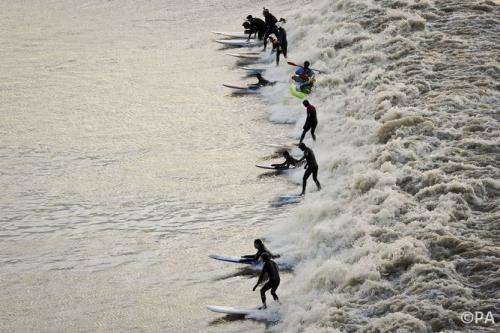Far from boring. Credit: Ben Birchall/PA Wire
Surfers and spectators gathered along the Severn Bore in Gloucestershire, England, in recent days to take advantage of the tidal wave that swept upstream. What's known as a tidal bore – a wave of up to 2.8 metres – came in from the Atlantic on Sunday and a five-star bore (the largest waves that occur) coursed up the river on Monday morning.
Tidal bores are one of the most famous tidal effects where rising water from the ocean creates tidal waves which wash inland, up rivers. They take place on the Amazon and the Qiantang River in Southeast China, where the event is held to be sacred and marked by temples and large crowds. On the Severn Estuary in Southwest England the all-important sea level can rise and fall as much as 14 metres in the space of 12 hours. That's the height of three double decker buses.
All around the world the sea level rises and falls every day with the tides. They vary from month to month, season to season and place to place. In the Mediterranean the tides are small. Along parts of the Atlantic and Pacific coasts their rise and fall can be extreme.
Pull of the moon
Tides are caused by the combining gravitational pull of the sun and the moon in relation to forces created by the spin of the earth. The gravity of the moon pulls at the earths surface, as water is "loose" it moves in response. Sometimes the gravitational pull of the sun (which is weaker on the earth as the sun is so far away) counteracts that of the moon and tides are lower. Sometimes the pull of moon and sun are in line (at new and full moon) and the highest, spring tides occur.
Before gravity was understood the tides were a great mystery to science and religion. The 8th Century British scholar and theologian, The Venerable Bede, wrote that the tides were somehow created by the breath of the moon. This is because the complex rhythm of the tides broadly follows the rhythm of the waxing and waning moon.
The Severn Estuary has the second highest tides in the world – after the Bay of Fundy in Canada – and the highest in Europe. The estuary is basically funnel shaped, going from west to east. This means that, as the Atlantic tide rises, a vast volume of water gets pushed up the estuary and, as the channel narrows, the depth of the river changes rapidly too into the lower reaches of the Severn River. As a result, the advancing top level of the water picks up speed and becomes a fully-fledged tidal wave followed by a surge of water.
On certain days of the year very high tides occur and these lead to what are called four or even five star bores – the biggest and most spectacular. The tidal wave gathers speed and height and crashes up the river channel making the Severn "the river that sometimes flows backward".
The record rainfall this winter threatened to hinder the height of the bore, which gains height from the river being shallow. But the river levels were able to drop back down as the rain subsided over the last couple of weeks, allowing for better bore forming over the weekend.
Gathering spectacle
Crowds gather to watch, websites show the best viewing areas and surfers and kayak canoeists come to ride the waves, adding to the drama and spectacle. The world record for the longest distance travelled in one go on a surfboard has been held on the Severn Bore by surfer Steve King. He rode the wave for a one hour and 16 minutes, travelling more than seven miles upstream.
Because of the way they are created the tides don't fit our normal day-night sequence in a simple way. High tides, and low tides – they always follow each other – can take place at any time, throughout the day or night. So they bring distinctive and special senses of time and rhythms to the places they affect. Both nature (such as wading birds) and society (sailors, farmers, fisher folk, walkers) must plan their day not by the clock of the sun, but by the clock of the moon.
Their unique timetable and the spectacular nature of tidal landscapes and phenomena such as the bore has been the inspiration for many artists and writers over the years. But tidal landscapes, despite being culturally and ecologically rich and unique, are under severe pressure nationally and internationally. Development, flood defences and land reclamation are serving to alter the often desolate and lonely – but very beautiful – landscapes of tidal areas.
Provided by The Conversation
This story is published courtesy of The Conversation (under Creative Commons-Attribution/No derivatives).![]()






















